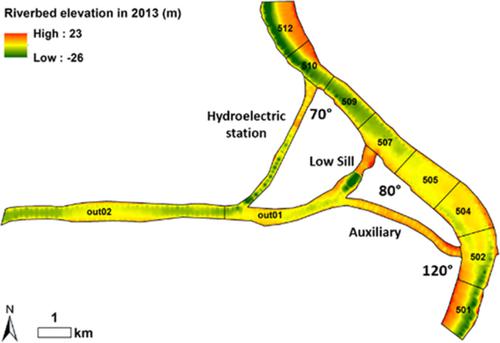当前位置:
X-MOL 学术
›
Hydrol. Process.
›
论文详情
Our official English website, www.x-mol.net, welcomes your
feedback! (Note: you will need to create a separate account there.)
Estimating bed material fluxes upstream and downstream of a controlled large bifurcation ‐ the Mississippi‐Atchafalaya River diversion
Hydrological Processes ( IF 2.8 ) Pub Date : 2020-04-17 , DOI: 10.1002/hyp.13771 Bo Wang 1 , Yi‐Jun Xu 1, 2
Hydrological Processes ( IF 2.8 ) Pub Date : 2020-04-17 , DOI: 10.1002/hyp.13771 Bo Wang 1 , Yi‐Jun Xu 1, 2
Affiliation

|
Bed material transport at river bifurcations is crucial for channel stability and downstream geomorphic dynamics. However, measurements of bed material transport at bifurcations of large alluvial rivers are difficult to make, and standard estimates based on the assumption of proportional partitioning of flow and bedload transport at bifurcations may be erroneous. In this study, we employed a combined approach based on observed topographic change (erosion/deposition) and bed material transport predicted from a one‐dimensional model to investigate bed material fluxes near the engineering‐controlled Mississippi‐Atchafalaya River diversion, which is of great importance to sediment distribution and delivery to Louisiana's coast. Yang's (1973) sediment transport equation was utilized to estimate daily bed material loads upstream, downstream, and through the diversion during 2004–2013. Bathymetric changes in these channels were assessed with single beam data collected in 2004 and 2013. Results show that over the study period, 24% of the Mississippi River flow was diverted into the Atchafalaya River, while the rest remained in the mainstem Mississippi. Upstream of the diversion, the bed material yield was predicted to be 201 million metric tons (MT), of which approximately 35 MT (i.e., 17%) passed through the bifurcation channel to the Atchafalaya River. The findings from this study reveal that in the mainstem Mississippi, the percentage of bed material diversion (83%) is larger than the percentage of flow diversion (76%); Conversely, the diversion channel receives a disproportionate amount of flow (24%) relative to bed material supply (17%). Consequently, severe bed scouring occurred in the controlled Outflow Channel to the Atchafalaya River, while riverbed aggradation progressed in the mainstem Mississippi downstream of the diversion structures, implying reduced flow capacity and potential risk of a high backwater during megafloods. The study demonstrates that Yang's sediment transport equation provides plausible results of bed material fluxes for a highly complicated large river diversion, and that integration of the sediment transport equation with observed morphological changes in riverbed is a valuable approach to investigate sediment dynamics at controlled river bifurcations.
中文翻译:

估算受控的大型分岔-密西西比-阿恰法拉亚河分流上游和下游的床料通量
河流分叉处的床层物质运输对于河道稳定性和下游地貌动力学至关重要。但是,很难对大型冲积河分叉处的床层物质输送进行测量,并且基于分流和床载输送量按比例分配的假设进行的标准估算可能是错误的。在这项研究中,我们采用了基于观测到的地形变化(侵蚀/沉积)和根据一维模型预测的床层物质运移的组合方法,来研究工程控制的密西西比河-阿塔法拉拉河分流附近的床层物质通量,这非常重要。对于沉积物分配和向路易斯安那州海岸的输送非常重要。Yang(1973)的沉积物迁移方程用于估算上游,下游,并通过2004-2013年的转移。用2004年和2013年收集的单波束数据评估了这些河道的等深线变化。结果表明,在研究期间,密西西比河的水流有24%流入了阿恰法拉亚河,其余部分则留在了密西西比河的主干中。在分流的上游,预计床层物料的产量为2.01亿吨,其中约35吨(即17%)通过分叉河道到达阿恰法拉亚河。这项研究的结果表明,在密西西比州的主干中,床料转移的百分比(83%)大于流量转移的百分比(76%)。相反,相对于床料供应(17%),转移通道接收的流量不成比例(24%)。所以,严重的河床冲刷发生在通往阿恰法拉亚河的受控流出河道中,而河床在分流结构下游的密西西比河主干河中逐渐凝结,这意味着在大洪水期间流量减少,并有回水的风险。研究表明,杨的沉积物输移方程为高度复杂的大型河流改道提供了合理的床层物质通量结果,并且将沉积物输移方程与观察到的河床形态变化相结合是研究受控河分岔处泥沙动力学的有价值的方法。这意味着大洪水期间流量减少,以及潜在的高回水风险。研究表明,杨的沉积物输移方程为高度复杂的大型河流改道提供了合理的床层物质通量结果,并且将沉积物输移方程与观察到的河床形态变化相结合是研究受控河分岔处泥沙动力学的有价值的方法。这意味着大洪水期间流量减少,以及潜在的高回水风险。研究表明,杨的沉积物输移方程为高度复杂的大型河流改道提供了合理的床层物质通量结果,并且将沉积物输移方程与观察到的河床形态变化相结合是研究受控河分岔处泥沙动力学的有价值的方法。
更新日期:2020-04-17
中文翻译:

估算受控的大型分岔-密西西比-阿恰法拉亚河分流上游和下游的床料通量
河流分叉处的床层物质运输对于河道稳定性和下游地貌动力学至关重要。但是,很难对大型冲积河分叉处的床层物质输送进行测量,并且基于分流和床载输送量按比例分配的假设进行的标准估算可能是错误的。在这项研究中,我们采用了基于观测到的地形变化(侵蚀/沉积)和根据一维模型预测的床层物质运移的组合方法,来研究工程控制的密西西比河-阿塔法拉拉河分流附近的床层物质通量,这非常重要。对于沉积物分配和向路易斯安那州海岸的输送非常重要。Yang(1973)的沉积物迁移方程用于估算上游,下游,并通过2004-2013年的转移。用2004年和2013年收集的单波束数据评估了这些河道的等深线变化。结果表明,在研究期间,密西西比河的水流有24%流入了阿恰法拉亚河,其余部分则留在了密西西比河的主干中。在分流的上游,预计床层物料的产量为2.01亿吨,其中约35吨(即17%)通过分叉河道到达阿恰法拉亚河。这项研究的结果表明,在密西西比州的主干中,床料转移的百分比(83%)大于流量转移的百分比(76%)。相反,相对于床料供应(17%),转移通道接收的流量不成比例(24%)。所以,严重的河床冲刷发生在通往阿恰法拉亚河的受控流出河道中,而河床在分流结构下游的密西西比河主干河中逐渐凝结,这意味着在大洪水期间流量减少,并有回水的风险。研究表明,杨的沉积物输移方程为高度复杂的大型河流改道提供了合理的床层物质通量结果,并且将沉积物输移方程与观察到的河床形态变化相结合是研究受控河分岔处泥沙动力学的有价值的方法。这意味着大洪水期间流量减少,以及潜在的高回水风险。研究表明,杨的沉积物输移方程为高度复杂的大型河流改道提供了合理的床层物质通量结果,并且将沉积物输移方程与观察到的河床形态变化相结合是研究受控河分岔处泥沙动力学的有价值的方法。这意味着大洪水期间流量减少,以及潜在的高回水风险。研究表明,杨的沉积物输移方程为高度复杂的大型河流改道提供了合理的床层物质通量结果,并且将沉积物输移方程与观察到的河床形态变化相结合是研究受控河分岔处泥沙动力学的有价值的方法。







































 京公网安备 11010802027423号
京公网安备 11010802027423号